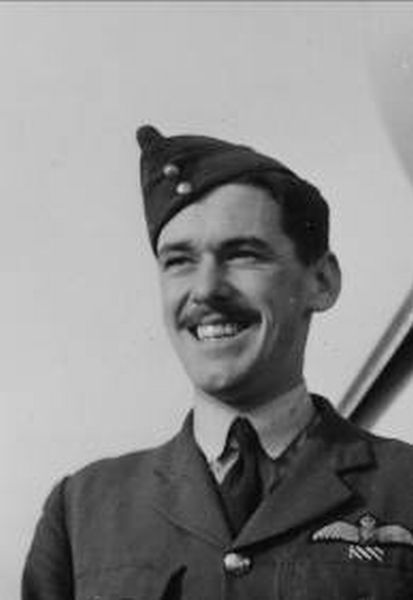Mungo-Park, John Colin
- Date of birth:
- March 25th, 1918 (Wallassey/Cheshire, Great Britain)
- Date of death:
- June 27th, 1941 (Adinkerke, Belgium)
- Buried on:
- Commonwealth War Cemetery Adinkerke
- Nationality:
- British
Biography
Service number 40008.
John Colin Mungo-Park was born in Wallasey, Cheshire in 1918.
He was educated at Liverpool College. When Mungo left college and the family moved to Bolton in 1934, he took up a position in the offices of Holden`s Mill, Astley Bridge, where he studied textile manufacture, finding time also to continue his sporting interests as a member of the Bolton Rugby Club and Sharples Tennis Club. When living in Bolton the Park’s neighbour was a Mr Bird who had gained his pilot’s licence in the 1920s and he also had a collection of aviation books, some relating the adventures of Great War fliers, which young Mungo avidly read.
Mungo joined the RAF on a Short Service Commission in June 1937 and was sent to 10FTS at Ternhill for initial training on 21st August 1937. Six months later he was posted to the Anti Aircraft Co-operation Unit of the Fleet Air Arm at Lee on Solent and then in August 1938 to HMS Argus, the Fleet Requirements Unit, to fly Fairey Swordfish.
At the beginning of the war, on 4th September, 1939, he was posted to No. 74 Squadron at RAF Hornchurch. He fought with this squadron all through the Battle of Britain and by the end of November, 1940, had twelve confirmed victories.
He had been commanding 'A' Flight of the squadron since 8 September 1940 and was promoted to command the squadron on 10 March 1941 when the existing commander, the famous South African 'Sailor' Malan, was posted to another appointment.
On 16th June, 1941, he shot down two Messerschmitt 109's over the French coast but his own aircraft was damaged and he glided back with a dead engine to crash land at Hawkinge near Folkestone.
On 27th June, 1941, in the Belgian coastal town of De Panne, just north of Dunkirk, teenager Joseph Recour was playing tennis with friends when they became aware of a lone Spitfire coming down, trailing smoke and crashing. Joseph and his friends immediately took to their bicycles and pedalled furiously in the direction of the crash site about two miles away. They found the wreckage of the Spitfire near the railway station at Adinkerke but couldn’t get close to it as Germans were already there, guarding it. But Joseph remembers clearly the body of the pilot lying beside it. John Mungo-Park was shot down and killed at Adinkerke, Belgium and is buried there, only a few miles away from the burial of his father, a WWI Lance Corporal who was killed as John Colin only was seven months old.
After the burial of John Colin, local inhabitants went to the grave and laid flowers – something which was expressly forbidden by the Germans and those who were caught doing so were punished. Joseph remembers that the wife of one of his friends was imprisoned for three months.
John Colin Mungo-Park was awarded a Bar to the DFC on 11 July 1941. It is, though as little as it is, comforting to know that he had heard that he was to be awarded a second DFC before he died.
August, 24, 1937: Acting Pilot Officer
May, 31, 1938: Pilot Officer
December, 31, 1939: Flying Officer.
december, 31, 1940: Flight Lieutenant
Do you have more information about this person? Inform us!
- Period:
- Second World War (1939-1945)
- Rank:
- Acting Flight Lieutenant
- Unit:
- No. 74 (Trinidad) Squadron, Royal Air Force
- Awarded on:
- November 15th, 1940
"In October, 1940, this officer was on patrol with his squadron at 30,000 feet when a formation of enemy aircraft were sighted. Flight Lieutenant Mungo-Park attacked a Messerschmitt 109 but had to break off the engagement as his windscreen became iced up. He cleaned this and again attacked the enemy aircraft and caused it to crash into the sea. He has personally destroyed eight hostile aircraft and has at all times displayed great courage and coolness in action."
- Period:
- Second World War (1939-1945)
- Rank:
- Acting Squadron Leader (Since reported missing.)
- Unit:
- No. 74 (Trinidad) Squadron, Royal Air Force
- Awarded on:
- July 11th, 1941
"This officer has performed excellent work in his many engagements against the enemy and has destroyed at least twelve of their aircraft. In June, 1941, he was attacked by six Messerschmitt 109's while over the French coast. He succeeded in shooting down two of these and, although his own aircraft was badly damaged, Squadron Leader Mungo-Park flew back to this country making a skilful forced landing. His courage and leadership have contributed materially to the successes achieved by his squadron."
Second DFC awarded as a bar for on the ribbon of the first DFC.
Sources
- Photo 1: 74 (F) Tiger Squadron
- Photo: 74 Squadron
- - Battle of Britain Memorial
- 74 Squadron
- CWGC
- The London Gazette Issue 34993 published on the 15 November 1940
- The London Gazette Issue 35217 published on the 11 July 1941



